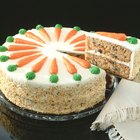
Fondant offers a satin-like finish to cakes, cupcakes and even sugar cookies. This sugary dough is kneaded, rolled and smoothed onto the surface of a pastry and allows bakers more durability than traditional frosting. As with any ingredient, things can go wrong and fondant is no different. Fondant that turns hard, however, isn’t always lost and might still be usable.
Type
Homemade and commercially prepared fondants harden differently. Commercially made fondant contains corn syrup, cornstarch, artificial colorings and flavorings, preservatives, glycerin and vegetable oil. Glycerin in the fondant keeps it from drying out quickly, but it still hardens to a soft shell once placed on a cake or pastry. Homemade fondant is typically made from corn syrup, powdered sugar, gelatin and water. While you can add glycerin to keep it from drying out, homemade fondant is naturally gummy and soft. Homemade fondant, however, doesn’t harden like commercially prepared fondant which means it remains soft and pliable while topping a cake.
Storing
Unused fondant needs adequate storage or it dries out and hardens. Store unused fondant in plastic wrap inside an airtight container. Commercially prepared fondant typically comes in plastic tubs with a plastic bag inside. You can store your fondant in these without additional preparation for up to two months at room temperature. Exposure to the air turns fondant hard and homemade fondant can dry out after being exposed to the air within a few days. Fondant can't be stored in the fridge or freezer. The humidity creates condensation, which breaks down the fondant’s natural sugars -- leaving you with a sticky, gummy mess.
Kneading
While kneading fondant, excess powdered sugar or cornstarch -- which help the fondant from sticking while being kneaded and rolled -- can make fondant dry and harden up. Counteract this by placing a small amount of vegetable shortening on your hands to incorporate moisture back into the fondant while kneading and rolling.
Fixing
If fondant has hardened during storage or while rolling, you may be able to soften it. Place the fondant in a microwave-safe bowl or on a place of parchment paper. Heat in the microwave on your lowest setting for five seconds. Check the fondant for pliability by pinching it between your fingers. Once the fondant is soft and pliable remove it and use it right away.
Related Articles

What Will Happen if You Refrigerate ...

Cupcake Decorating Ideas Without ...

How Early Can You Make a Wedding Cake?

Can I Change the Color of Rolled ...

How to Make a Fake (Faux) Cake

How to Defrost a Frozen Cake With ...

How Long After You Bake Should You Put ...

How to Make a Box Cake Firmer to Frost

Can Softened Frosting Harden Over a ...

How to Preserve Fondant

Can You Make Dumplings With Corn Starch?

How to Keep Cake Moist Overnight ...

The Difference Between Butter Cream and ...

Do You Need to Refrigerate Whipped ...

How to Make Shiny Icing for Cookies ...

What Do You Use to Make Fondant Stick?

Can You Use Heavy Cream When Making ...

The Uses for Dry Fondant
How to Measure Fondant

How to Handle Sticky Dough
References
- On Baking: A Textbook of Baking and Pastry Fundamentals; Sarah R. Labensky
- The Baking Pan: Rolled Fondant Tips
Writer Bio
Shailynn Krow began writing professionally in 2002. She has contributed articles on food, weddings, travel, human resources/management and parenting to numerous online and offline publications. Krow holds a Bachelor of Science in psychology from the University of California, Los Angeles and an Associate of Science in pastry arts from the International Culinary Institute of America.
Photo Credits
Stockbyte/Stockbyte/Getty Images